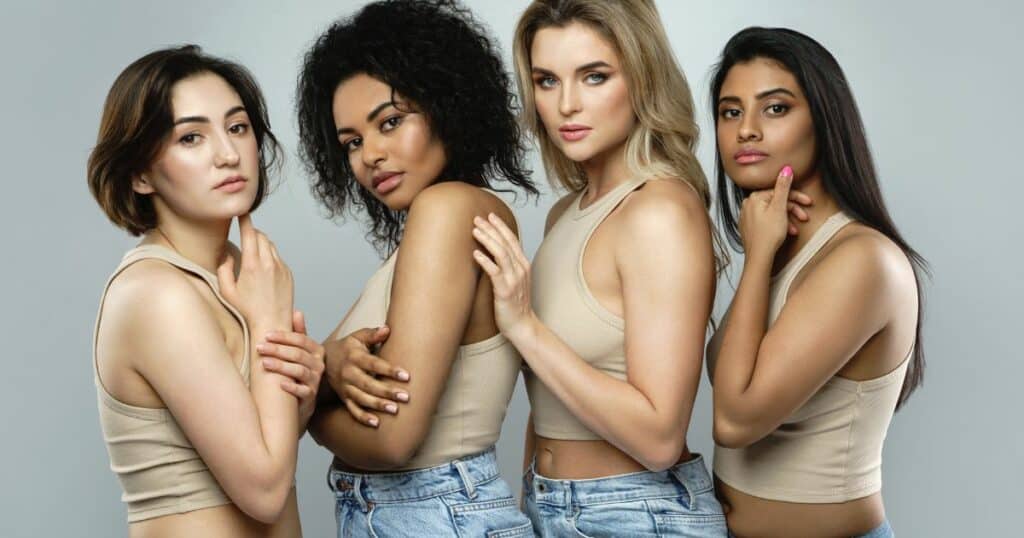Hair Types Guide: Understanding the intricate diversity of human hair is essential for its care, styling, and maintenance. Each type has unique characteristics and needs, from straight to curly and everything in between. Dive into our comprehensive guide to explore the various hair types, their textures, and how best to care for each.

Hair types can vary greatly, and understanding the unique characteristics of one’s hair is essential for proper care and styling. Diverse hair types can be classified by texture, curl pattern, and thickness. Recognizing and embracing one’s specific hair type can make it easier to manage and result in healthier, more vibrant locks.
From straight to wavy, curly, and coiled, each hair type presents its unique challenges and opportunities. Additionally, the thickness of individual strands can range from fine to medium to coarse. Individuals can make informed choices about relevant products and treatments by identifying and categorizing one’s hair.
Caring for each hair type may require different approaches, techniques, and tools. Equipped with knowledge about their hair type and appropriate care instructions, people can improve their hair’s overall health and appearance. Exploring various hair types and their respective characteristics is essential for personalized, effective hair care.

Understanding Hair Types
Knowing your hair type is essential for proper hair care and styling. Hair types can be categorized into four main groups: straight, wavy, curly, and coiled or kinky hair. Each category has three subcategories, denoted A, B, and C. A hair type chart can help you identify which category and subcategory your hair falls into.
Type 1: Straight Hair

Straight hair, or type 1, lies flat on the scalp and usually appears glossy due to its ability to evenly distribute natural oils. The subcategories are as follows:
- 1A: Very fine and thin straight hair
- 1B: Medium-textured straight hair
- 1C: Coarse and thick straight hair
Type 2: Wavy Hair

Wavy hair, or type 2, showcases a slight bend or wave pattern that forms the shape of an “S.” The subcategories for this category are:
- 2A: Loose waves with fine texture
- 2B: Medium waves with slightly more defined texture
- 2C: Coarse waves with a strong, frizz-prone texture
Type 3: Curly Hair

Curly hair, or type 3, features well-defined, springy curls that form spirals or ringlets. The subcategories for curly hair are:
- 3A: Loose, large curls with a shiny texture
- 3B: Medium-sized curls with more volume
- 3C: Tight, corkscrew curls with a higher density
Type 4: Coiled or Kinky Hair

Kinky or coiled hair, or type 4, is characterized by its tight, zigzag pattern. This hair type is often more fragile and prone to breakage. The subcategories are as follows:
- 4A: Soft, springy coils with a defined, spongy texture
- 4B: Firmer, more angular coils with a Z-shaped pattern
- 4C: Very tight coils that may not have a clearly defined pattern
Understanding these hair types and their respective subcategories is crucial for choosing the appropriate hair care routines, products, and styling techniques that will work best for your hair type. A hair type chart is a valuable tool to visually guide you through the process. You can confidently approach hair care with more knowledge and better results by identifying your unique hair type.
Type 1: Straight Hair
Type 1 hair is classified as straight hair. It has no natural curl pattern and lies flat on the scalp. This hair type can be of varying thicknesses and falls into three categories: Type 1A, Type 1B, and Type 1C.
Type 1A straight hair is thin, delicate, soft, and shiny. It has a wispy texture and often lacks volume. Due to its delicate nature, it might not hold curls well. On the other hand, Type 1B straight hair has more body than Type 1A and is of medium thickness. This hair type can hold styles better and has some volume, making it more versatile for styling options.
Lastly, Type 1C straight hair is generally thick and has more body and a bit of natural bend. Though it is still considered straight, it might require more effort to maintain its appearance and manage its thickness compared to its counterparts.
A common issue associated with straight hair is oiliness. Since there are no curls or waves to obstruct the flow of sebum, the natural oil produced by the scalp, it can easily travel down the hair shaft, resulting in an oily appearance. To address this, frequent washing and using lightweight hair products can help keep oiliness under control.
When styling Type 1 hair, it is essential to use appropriate tools and techniques. For instance, fine or thin hair should be handled gently to avoid breakage or damage. Heat protectants can be beneficial when applying heat with a curling or flat iron. Moreover, some styling products, like silicone-based ones, can weigh down straight hair or increase oiliness, so it’s crucial to be mindful of the ingredients used.
In summary, Type 1 straight hair can be categorized into three subtypes based on thickness and texture. Each subtype has unique properties and styling requirements, but a common issue for this hair type is managing oiliness. By using appropriate hair care techniques and styling products suited to each subtype, individuals with Type 1 straight hair can maintain a healthy and beautiful appearance.
Type 2: Wavy Hair
Type 2 hair is characterized by its natural wavy pattern and is classified into three subcategories: type 2A, 2B, and 2C. Each subcategory represents a variation in the wave’s structure and appearance.
Type 2A hair has a gentle S-shaped pattern with soft and barely visible waves. This hair type has a fine texture and is prone to frizz. To maintain and enhance these subtle waves, it’s essential to use lightweight styling products like mousse to avoid weighing down the hair.
Type 2B hair features more distinct waves that cascade from the mid-length to the ends. These waves have a medium texture and are slightly tighter than type 2A. To reduce frizz and define the waves, it’s crucial to keep the hair well-hydrated and use products like leave-in conditioners and light hair serums.
In contrast, type 2C hair exhibits a mix of both waves and curls with a coarser texture. Due to this hair type’s dense and complex nature, it requires extra care to maintain its healthy shine and minimize frizz. Regular deep-conditioning treatments and the use of hydrating products are essential.
When styling wavy hair, choosing the right tools and techniques to enhance the natural wave pattern is essential. A wide-tooth comb or a brush with flexible bristles can help detangle the hair without causing breakage.
Furthermore, using heat tools sparingly and on a low-to-medium setting will avoid causing damage to the hair’s structure. To create defined waves, scrunching the hair with lightweight gels or creams and allowing it to air-dry will yield the best results.
In summary, type 2 wavy hair requires proper care and attention to maintain its beautiful waves. By understanding the specific needs of each subcategory and selecting the appropriate products, styling techniques, and tools, one can achieve a healthy, gorgeous, and frizz-free mane.
Type 3: Curly Hair
Type 3 hair, typically known as curly hair, is characterized by its distinctive S-shaped curl pattern. Curly hair comes in various subcategories, such as type 3A, 3B, and 3C, each with its curl diameter and texture.
Type 3A hair features loose, large ringlets with a consistent S shape from roots to ends. This curly hair type is generally easy to manage and can retain moisture well. To maintain its natural bounce and shape, using a lightweight conditioner and avoiding heavy styling products that may weigh the hair down is essential.
Type 3B hair is characterized by medium-sized, springy curls that form a tighter pattern than type 3A. It may be prone to frizz and dryness, so hydration is crucial for this hair type. A deep conditioner and applying a gel or cream-based styling product can help minimize frizz and define the curls.
Type 3C hair has the tightest curl pattern among the type 3 curly hair types. It features petite, tightly-coiled spirals prone to shrinkage and damage from heat and chemical treatments. To maintain the health and appearance of type 3C curls, it’s essential to provide ample moisture, avoid excessive heat, and use gentle styling techniques.
Styling curly hair generally requires special attention and a focus on preserving the curl pattern while avoiding dryness and damage. When dealing with type 3 hair, consider using a leave-in conditioner and a gel or mousse that provides hold and moisture. Also, avoid brushing dry curly hair, which can cause frizz and breakage. Instead, opt for finger-detangling or using a wide-tooth comb while the hair is wet and loaded with conditioner.
In summary, type 3 curly hair encompasses a range of curl patterns, from loose ringlets to tight, springy spirals. Ensuring adequate moisture, avoiding heat damage, and choosing the right styling products and techniques will help maintain the health and beauty of this unique hair type.
Type 4: Coily Hair
Type 4 hair, known as coily or kinky, consists of tightly coiled strands that often follow a zigzag pattern. This hair type is subdivided into three categories: 4A, 4B, and 4C. Each of these types has unique characteristics that require specific hair care routines.
4A hair has a well-defined S-shaped curl pattern with tight, springy coils. This hair type has more moisture than other coily hair types, but it is still prone to breakage and damage if not properly maintained. To care for 4A hair, use gentle shampoos, deep conditioners, and hair masks to keep the hair moisturized and manageable. Also, incorporating leave-in conditioners and light styling products can help maintain curl definition and control frizz.
4B hair has a tighter Z-shaped curl pattern and is known for its wiry texture. This type is more fragile and susceptible to breakage due to its fewer cuticle layers. Maintaining moisture is essential for 4B hair, and using heavier conditioners and hair masks can help protect the hair from damage. Avoid harsh brushing and opt for finger detangling to minimize breakage. Styling 4B hair requires products like creams and gels to maintain the texture and definition of the curls.
4C hair is the tightest and most delicate of the coily hair types, with a curl pattern that is difficult to define unless manipulated through various styling techniques such as twisting and braiding. This hair type needs consistent moisture and gentle handling to prevent damage and tangles. To care for 4C hair, use sulfate-free shampoos, deep conditioners, and regular hair masks. Incorporate leave-in conditioners and moisturizing stylers to maintain hydration and curl definition. Protect your 4C hair by opting for low manipulation and protective styles like braids, twists, and buns.
When it comes to coily hair care, remember that choosing the right products for your specific type is critical. Look for products that nourish and moisturize the hair, as retaining moisture is a common concern for those with type 4 hair. Avoid harsh chemicals, excessive heat, and rough handling to minimize damage and breakage. Emphasize gentle washing, conditioning, and styling practices to preserve the natural curl pattern and maintain healthy, beautiful hair.
Hair Texture and Density
Hair texture and density are essential when determining hair type and the appropriate care and styling methods. Both texture and density play a role in the overall appearance and manageability of the hair.
Hair texture refers to the thickness of individual hair strands and can be classified into three categories: fine, medium, and thick. Fine hair is the most fragile texture and consists of only two layers: the cortex and the cuticle. Medium hair has a thicker diameter than fine hair and is more resilient, while thick hair is the strongest, with the largest diameter and a coarse feel. Each hair texture has unique characteristics, affecting the hair’s response to styling and care treatments.
Hair density refers to the number of hair strands growing per square inch on the head. The density can range from low to high, and it is possible to have varying densities across different areas of the scalp. One can perform a simple ponytail test to determine one’s hair density. For this, create a ponytail using a hair elastic and observe how many times it wraps around the ponytail. If the elastic wraps only once, the hair is thick; if it wraps two to three times, the hair has medium density; however, if it wraps more than three times, it has low density.
Understanding hair texture and density is essential for selecting the right products, hairstyles, and routine maintenance. For example, fine hair typically benefits from volumizing products and lightweight conditioners, while thick hair may require more moisturizing and deep-conditioning treatments. In terms of hairstyles, low-density hair generally looks better with blunt cuts and layered styles that create the illusion of fullness. On the other hand, high-density hair can handle a broader range of styling options but may require more time-consuming processes to achieve the desired look.
In conclusion, knowing one’s hair texture and density is crucial to ensuring proper hair care and achieving a healthy, beautiful appearance. By catering to the specific needs of each hair type, individuals can enhance their hair’s natural beauty and enjoy more manageable tresses.
Hair Care Products
Hair care is essential for maintaining healthy, beautiful locks. Different hair types require specific products to address their unique needs. This section provides a brief overview of some of the essential hair care products suitable for various hair types.
Shampoos cleanse and remove dirt, oil, and product buildup from the hair. They come in different formulations to cater to different hair types, such as shampoos for frizzy hair, volumizing shampoos for fine hair, and moisturizing shampoos for dry or damaged hair. For example, John Frieda Frizz Ease Dream Curls Curl Defining Shampoo suits frizzy hair.
Conditioners work to restore moisture and nutrients to the hair after shampooing. Like shampoos, they come in various formulations to address specific hair needs. A moisturizing conditioner, such as L’Oréal Paris EverPure Moisture Conditioner, is ideal for dry hair.
Leave-in conditioners are applied after washing and can provide extra moisture, detangle, and protect hair from heat styling tools. They benefit people with dry or damaged and curly or coily hair.
Hair masks are deep conditioning treatments that can nourish and repair hair, usually applied once or twice a week. Hair masks offer targeted benefits, such as repairing damaged hair, moisturizing dry hair, or smoothing frizzy hair.
Hair oils are another essential product for healthy hair. They help to nourish, protect, and add shine to the hair. Examples include argan oil, coconut oil, and olive oil. Application varies by hair type, with finer hair requiring lightweight oils and coarser hair benefiting from heavier oils.
Dry shampoos absorb excess oil from the scalp and refresh hair between washes. They are perfect for people with oily hair or those who want to extend the life of their hair styling.
Styling products such as sprays, mousse, and gels provide hold, definition, and protection for various hair types and styles. Hairspray offers flexible or strong hold for updos and other styles, while gel and mousse give definition and hold to curls and waves.
In conclusion, selecting the proper hair care products is crucial for achieving and maintaining healthy hair. By understanding the specific needs of your hair type and using appropriate shampoos, conditioners, and styling products, you can enjoy beautiful, manageable locks throughout the year.
Styling and Maintaining Different Hair Types
Understanding your hair type is essential for proper styling and maintenance. Every hair type requires a different approach to maximize its beauty and health. This section will guide styling and maintaining hair types using various tools and products.
Straight hair usually lacks volume and can become oily more easily. To combat this, use a gentle shampoo and conditioner to remove excess oils without stripping the hair of its natural moisture. Overwashing can lead to oily hair, so limit washing to every other day. When styling, use a volumizing mousse or spray to add to the body. Opt for a wide-toothed comb or paddle brush to detangle and avoid breakage. Avoid overusing heat tools such as flat irons, as excessive heat exposure damages hair.
Wavy hair can be prone to frizz and benefits from products that manage and define curls. Use sulfate-free shampoos and conditioners for wavy or curly hair to retain moisture. After washing, apply a leave-in conditioner to protect from heat and lock in natural oils. Gels or creams can help define and enhance the natural curl pattern. Utilize a diffuser attachment when blow-drying to maintain waves while reducing frizz. A microfiber towel or cotton T-shirt can gently scrunch and dry the hair.
Curly hair requires extra effort to maintain moisture and control frizz. Opt for sulfate-free shampoos, especially those formulated for curly hair, and nourishing conditioners that hydrate and lock in softness. Deep conditioning treatments should be done once a week to fight dryness and damage. Styling products like curl-enhancing creams, gels, and mousses can be applied to manage curls and tame frizz. Use a wide-toothed comb or detangling brush on wet hair to minimize breakage. Invest in a diffuser for drying, as it maintains curl definition and minimizes frizz.
Kinky or coiled hair is highly susceptible to dryness and damage and needs an intense focus on moisture retention and breakage prevention. Invest in nourishing shampoos and conditioners formulated for this hair type and frequent deep conditioning treatments. Regular use of moisturizing products like leave-in conditioners, hair butter, and oils can help retain moisture. For styling, opt for gels, creams, or pomades that enhance curls and prevent shrinkage. When detangling, use a wide-toothed comb or finger combing to avoid hurting the hair. Protective styles like braids or twists can limit damage and promote healthy hair growth.
In summary, understanding and catering to the specific needs of your hair type will result in healthier, more manageable hair. Following the tailored styling and maintenance tips ensures your hair reaches its full potential and exudes confidence and beauty.
Hair Porosity and Health
Hair porosity refers to the hair’s ability to absorb and retain moisture. It plays a crucial role in maintaining hair health, as poor moisture absorption can lead to damage, breakage, and dryness. There are three types of hair porosity: low, average (medium), and high.
Low-porosity hair has tightly packed cuticles, making it difficult for moisture to penetrate the hair shaft. This can result in a lack of hydration and, consequently, breakage. Individuals with low porosity hair should use lightweight, water-based products and opt for regular deep conditioning treatments to improve moisture absorption.
Normal porosity hair has relatively loose cuticles, allowing for easy moisture penetration. This hair type is the easiest to maintain, as it generally has a good hydration balance. To keep normal porosity hair healthy, it’s recommended to use deep conditioning masks occasionally for optimal hair health.
High porosity hair has gaps or holes in the cuticle layer, causing it to absorb and lose moisture quickly. Often, high porosity hair results from damage due to chemical treatments, heat styling, or environmental factors. It’s essential to incorporate protein treatments, heavier moisturizing products, and sealants to lock in hydration and reduce moisture loss to manage high-porosity hair.
When caring for various hair porosity types, choosing the appropriate shampoo, conditioner, and hair mask tailored to the individual’s moisture and hydration needs is crucial. Regularly monitoring hair health and adjusting the hair care routine accordingly can significantly benefit the overall health and durability of the hair, reducing the risk of damage and breakage in the long run.
Identifying Your Hair Type
Knowing your hair type is essential for selecting the right products and styling methods. Hair types are generally classified into four main categories: Type 1 (straight), Type 2 (wavy), Type 3 (curly), and Type 4 (coily). Hairstylist Andre Walker established these categories, which are widely recognized. Each type also has subcategories (A, B, and C) based on the hair’s texture and curl pattern.
To identify your hair type, follow these steps. First, examine your hair’s curl pattern to identify your hair type. Type 1 hair is straight, while Type 2 has a slight wave (forming an S-shaped pattern). Type 3 hair has more defined curls, and Type 4 represents the tightest coil pattern. The subcategories within each type help refine identification based on slight differences in curl tightness and hair texture.
Next, consider your hair’s texture. Depending on the width of individual strands, hair can be categorized as thin, medium, or thick. A simple way to test this is to compare a single hair strand to a piece of thread. If your hair strand is thinner than the thread, it is thin; if it is similar in thickness, it is medium; and if it is thicker, it has a thick texture.
Finally, evaluate your hair’s density, which relates to the number of hair strands on your scalp. People with low-density hair have fewer strands and may appear to have less volume. Medium-density hair is balanced, while high-density hair appears fuller and thicker. To assess your hair density, part your hair and observe the amount of scalp visible. A less visible scalp indicates a higher density.
A hair type chart can help narrow down your hair type and subcategory. The chart illustrates different hair textures, curl patterns, and densities, allowing for a more accurate self-assessment. Understanding your hair type is a vital first step in guiding you toward the appropriate styling and care techniques for your unique hair characteristics.
Frequently Asked Questions
What are the main categories of hair texture?
There are four main categories of hair texture: Type 1 (straight), Type 2 (wavy), Type 3 (curly), and Type 4 (coiled). Each hair type is further divided into sub-types, 1a, 1b, 2a, etc., to represent the texture variation within each category.
How can I identify my specific hair type?
Observe your hair when it’s most natural after air-drying without using any products to identify your specific hair type. Look for the curl pattern and the diameter of the hair strand to determine your hair type. Consult a hair type chart that classifies hair and sub-types for more accurate identification.
What determines curly, wavy, and straight hair?
Curly, wavy, and straight hair are determined by the shape of the hair follicle and the distribution of proteins within the hair shaft. Curly hair has more oval-shaped follicles and an uneven protein distribution, while wavy hair has slightly oval follicles and a more balanced protein distribution. Straight hair has round follicles and an even protein distribution within the hair shaft.
How do hair types vary among different ethnicities?
Hair types can vary significantly among different ethnicities due to genetics, climate, and cultural practices. While Asian hair is typically straight and thick, African hair is often tightly coiled and porous. Caucasian hair shows the most variation, ranging from straight to curly and fine to coarse.
Which hair care products work best for different hair types?
The ideal hair care products depend on an individual’s hair type and specific needs. For example, straight hair may require a volumizing shampoo and conditioner, while curly hair benefits from moisture-rich products to define and maintain curls. It is essential to select products specifically designed for your hair type to meet its unique needs effectively.
Are there unique ways to style various hair types?
Yes, styling techniques can vary based on hair types and textures. Straight hair may be more easily manipulated using heat styling tools such as flat irons, while curly hair often benefits from air-drying or diffusing to retain its curl pattern. Wavy hair can be enhanced with scrunching or a curling rod, and coiled hair styles are best when working with its natural texture to prevent breakage. Experimenting with different techniques and tools can help identify the best styling methods for each hair type.





